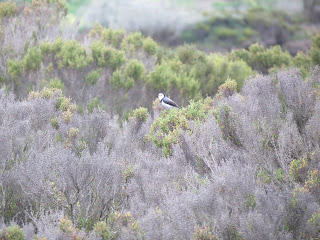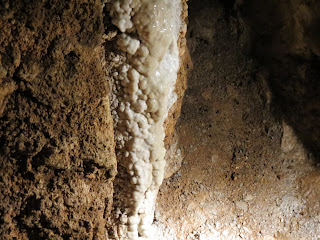I don't know much about mammals, but I have seen many of them since when I started birding. This post is about a certain type of mammal, the macropod. Macropods are a group of marsupials. They include pademelons, kangaroos, wallabies, bettongs and potoroos. All macropods belong to the suborder
Macropodiformes, and there are several families in that order. From the primitive
musky rat-kangaroo to the largest of the macropods, the
red kangaroo, they show lots of diversity. Here are the macropods I have seen.
The
agile wallaby Macropus agilis is the commonest wallaby in many parts of northern Australia. There are four subspecies, of which I have seen one. Subspecies
agilis is found in the northern territory, subspecies
jardinii is found in northern and eastern Queensland, subspecies
nigrescens is found in the Kimberly region of Western Australia and finally subspecies
papuanus is found in southern and southeastern Papua New Guinea, as well as a few neighbouring islands. I have seen an agile wallaby once before, when I went to Kakadu National Park (before I started this blog) but I do not currently have any photos of it.
WESTERN GREY KANGAROO (subspecies melanops)
The
western grey kangaroo Macropus fuliginosus is one of the two species of grey kangaroo. It is very common and found in much of southern Australia, from western Victoria to southwestern Queensland, and then north to Shark Bay, as well as in the Murray-Darling Basin of New South Wales and Queensland. There are two subspecies, subspecies
melanops in almost all of its range and subspecies
fuliginosus on Kangaroo Island. This species of kangaroo is closely related to the eastern grey kangaroo. This is a rather large species of macropod.
EASTERN GREY KANGAROO
The
eastern grey kangaroo Macropus giganteus is found in southern and eastern Australia, as well as Tasmania, and is the second largest living marsupial in Australia. Though the red kangaroo is better known, this is the kangaroo most often encountered in Australia due to its adaptability. In Victoria it is the commonest and most widespread of the three species of kangaroo. This was the first of the two species of grey kangaroo to be discovered, and for a while the western grey kangaroo was considered the same as this species.
WHIPTAIL WALLABY
The
whiptail wallaby Macropus parryi, also known as the pretty-faced wallaby, can be found in eastern Australia from Grafton in New South Wales to Cooktown in Queensland (at least, that is where it is commonest). In the right places it is very common. The area around Lamington National Park is one of these places, and if you are there at the right time you will almost certainly see at least one as you are driving along the road. This species of wallaby can be found in grasslands and woodlands, particularly on hills or slopes. It mostly grazes to get its food. It is a sociable animal that can sometimes come together in groups of up to 50 wallabies.
RED-NECKED WALLABY
The
red-necked wallaby Macropus rufogriseus is a medium-sized wallaby fairly common in temperate eastern Australia, including Tasmania. There is also a small colony of escaped animals on the island of Inchconnachan in Scotland, and some have been introduced to parts of New Zealand. There are two subspecies. Subspecies
rufogriseus is found only in Tasmania, and is called Bennett's wallaby, and subspecies
banksianus is found on the mainland. In Tasmania and coastal Queensland their numbers have expanded. They are mainly solitary but will gather together where or when there is an abundance of resources. They are mainly crepuscular, coming out mostly during dawn and dusk and staying in or near vegetation for the middle of the day.
The
red kangaroo Macropus rufus is the largest of Australia's native mammals, and the largest marsupial that is not extinct. Males have short, red-brown fur, while females are blue-grey. The red kangaroo is found mostly in inland Australia, and is mostly crepuscular, resting in the shade for most of the day. Adult red kangaroos currently have no real predators, with their powerful kicks and blows that can break human bones, but when thylacines weren't extinct they killed and ate kangaroos. However, dingoes and eagles will kill and eat joeys they can get to. They are excellent swimmers and often flee into waterways if threatened. If pursued they sometimes use their forepaws to drown predators by holding them underwater. They live in groups of two to four members. I have seen the red kangaroo in inland New South Wales, near Mildura, while on a trip with my cousins who live there.
The
red-legged pademelon Thylogale stigmatica is a small macropod found in northeastern Australia and New Guinea. It is normally solitary, but sometimes groups together when feeding. There are four subspecies. Subspecies
wilcoxi is in southern Queensland and New South Wales,
stigmatica in the Cairns region
, coxenii in the Cape York Peninsula and
orimo in New Guinea. This shy creature feeds mostly on fallen fruit, leaves and grasses. Lamington National Park in southeastern Queensland is probably the best place to see this, and it is where I saw it (though I only got glimpses of animals dashing into the undergrowth).
RED-NECKED PADEMELON
The
red-necked pademelon Thylogale thetis is another small species of macropod that is closely related to the red-legged pademelon, though it is much less shy. In many places it is mainly nocturnal, hiding in the forests by day and grazing on grasslands in the dusk, night and early morning. In the early morning at O'Reilly's Rainforest Retreat in Lamington National Park these pademelons can be seen feeding on the lawns.
SWAMP WALLABY
The
swamp wallaby Wallabia bicolor is a small wallaby that can be found in much of eastern Australia, including Victoria. It is also known as the black wallaby. It is one of the three macropods found in the Greater Melbourne area (along with long-nosed potoroos and eastern grey kangaroos). I have seen these wallabies at many places. Phillip Island can be a very reliable place to see these if you are at the right part of the island. Apparently they can also be found at Brimbank Park, though I have not seen one there yet. They are the only species in the genus
Wallabia. The photo above was taken at Serendip Sanctuary.
Those are the macropods I have seen.









































